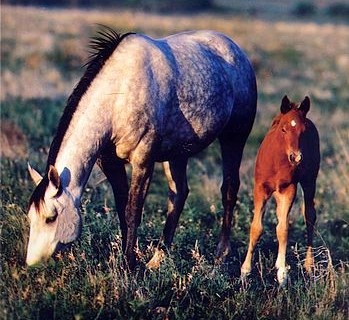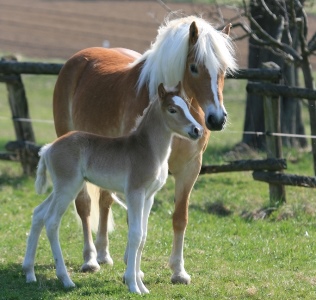The arrival of a foal is always an exciting time regardless of whether you have a large breeding farm or just one mare to foal out. What happens when an emergency arises and you find yourself with a very young orphan foal that needs milk? Problems that may arise include: the mare dies during or soon after foaling, the mare colics or has other health issues which require emergency intervention, the mare rejects the foal, and/or the mare does not produce enough milk or “dries up.” There is always the option of bottle feeding these foals but this is a very time consuming process and the foal could tend to be more socialized towards humans than horses. These unfortunate circumstances are the perfect time to consider a nurse mare who can be brought in to adopt and raise the orphaned foal.
Colostrum
If you do find yourself in this situation the most important first step is making sure the newborn foal gets colostrum. You can read more about this important step in our article Why Colostrum Transfer is Critical to a Foal’s First Weeks of Life.
How to Find a Nurse Mare
Nobody wants to think about these events happening to their mare or foal but it is always a good idea to be prepared so you won’t be caught off guard in an emergency situation. You can search on the internet for farms in your area that offer nurse mare services, contact facilities with embryo transfer recipient herds or contact a large breeding farm in the area who will likely be able to get you in touch with their contacts. It is recommended you prepare for the worst and do your research prior to breeding season so you are not searching for who to call in an already stressful situation.
How to Introduce the Nurse Mare to the Orphan Foal
Once you have located an available nurse mare, what’s next? It’s NOT recommended to just put the two in a stall together and hope they get along. So, let’s take a look at how to go about introducing a nurse mare and the orphan foal. Because no two situations are the same, there is never an answer that will fit every situation. It often takes trial and error to find what works for a particular mare and foal as well as lots of staff.
 First, it is a good idea to start with a nurse mare that is mild-mannered, as she will be more likely to accept the foal as her own. It is best to restrict the foal’s access to milk for several hours prior to the introduction so he is hungry and ready to nurse. When you are ready to introduce the mare into the stall with the orphan foal, make sure there is someone to handle the mare as well as someone to restrain and keep the foal at a safe distance until he is ready to be slowly introduced to the nurse mare.
First, it is a good idea to start with a nurse mare that is mild-mannered, as she will be more likely to accept the foal as her own. It is best to restrict the foal’s access to milk for several hours prior to the introduction so he is hungry and ready to nurse. When you are ready to introduce the mare into the stall with the orphan foal, make sure there is someone to handle the mare as well as someone to restrain and keep the foal at a safe distance until he is ready to be slowly introduced to the nurse mare.
Settle the nurse mare into the stall while the foal is safely restrained and cannot reach her. The nurse mare absolutely needs to be restrained in the stall and will need to remain that way until she has fully accepted the foal. Evaluate the situation and the stall set up to decide on the best method for restraining her. The mare can be tied, hobbled, have a hind leg tied up off the ground, or any combination of restraint methods but you want to use the least amount of restraint necessary. A mare that is stressed about her restraints will worry more about that and be unable to focus on allowing a new foal to nurse. Also, make sure the nurse mare has access to plenty of hay and water that is easy to reach while she is tied. Several tools that can be utilized to help keep the mare calm and receptive to the initial introduction include: sedating the mare (this is highly recommended during the first meeting), blindfolding the mare and/or putting Vicks inside the mare’s nostrils and along the back of the foal to disguise the scent of the unfamiliar foal.
Allow the foal to slowly approach the mare’s udder and try to nurse. The foal handler should stay very close to the foal so he can be pulled away from the mare if necessary. Make sure the foal uses “good manners” when trying to nurse. Don’t let him aggressively bump the mare’s bag, bite, etc. The nurse mare handler should help distract and keep the nurse mare calm and quiet. This part of the process may take only a few attempts or it may take several days to be fully successful. If this takes several days you will need to take steps to ensure the mare does not dry up, such as: milking out the mare, giving oxytocin injections, etc.
 When the mare is allowing the foal to nurse, gradually decrease the amount of restraint with constant supervision until the mare has fully accepted the foal as her own. You can test this bond by leading the mare out of the stall. A good sign they have bonded is if she looks for and nickers to the foal and the foal wants follow the mare.
When the mare is allowing the foal to nurse, gradually decrease the amount of restraint with constant supervision until the mare has fully accepted the foal as her own. You can test this bond by leading the mare out of the stall. A good sign they have bonded is if she looks for and nickers to the foal and the foal wants follow the mare.
Once the nurse mare has accepted the foal, and the foal is confident with his new situation, there are typically very few problems. The nurse mare will continue to bond with the foal and raise it as her own. However, continue to monitor the pair to watch for any warning signs that things aren’t going as planned. Make sure you continue to observe the foal nursing when there is no restraint or supervision, and both the mare and foal act normally. Watch the foal’s weight gain and overall attitude to ensure he is getting the nutrition he needs and growing appropriately.
The benefits of utilizing a nurse mare to raise an orphaned foal are well worth the time and work it takes to help them to bond. Bottle feeding an orphan foal takes round-the-clock man power and milk replacers can be quite costly. Foals that have been exclusively bottle fed often develop unwanted behavioral issues from the lack of equine companionship. Orphans that are raised on a nurse mare, on the other hand, are provided with the best possible nutrition and learn normal equine social behaviors by being raised in a much more natural environment.
See Also:
The Orphan Foal - How to Achieve a Positive Outcome


Log in to join the conversation.
Group,
The loss of a post foaling mare is such a difficult time for all involved, especially for owners, caretakers, and veterinarians alike. Over my career, I think one of the most rewarding moments are the successful grafting of a orphaned foal onto to nurse mare or recipient mare that is induced into lactation. One point that I struggle with is the fact that the nurse mare herself was bred and delivered a foal of variable worth in the horse market. Are we contributing to the unwanted horse? Of late, I have begun grafting orphaned foals onto our older recipient mares (with an induced lactation) and have found it a wonderfully rewarding experience. We see these proven recip mares continue to contribute to our practice and nurse, raise, and train these orphaned foals through weaning.
We had a wonderful experience with Roseberry Nurse Mares of Kentucky. Our Arabian mare died of ovarian artery rupture 12 hours after her colt foal was born. We were almost paralyzed with grief, but Roseberry came to our rescue. Shaikh al Nadir was successfully raised by his nurse angel mommy “Blondie”, a Belgian/Haflinger cross. She was an excellent mother and Shaikh had the benefit of a mom to run to and plenty, and I mean plenty of milk!